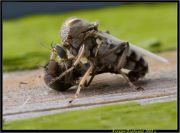Diptera.info :: Identification queries :: Diptera (adults)
Who is here? 1 guest(s)
|
Nematocera
|
|
| Dima DD |
Posted on 01-12-2008 01:19
|
|
Member Location: St.Petersburg, Russia Posts: 75 Joined: 28.11.05 |
Dear friends, this good photo of predaceous gnat (male?) with double large claws is not mine (author: Vladimir Anikeev). What gnat is it? Could it be Mycetobiidae? http://macroclub.ru/gallery/showphoto.php/photo/9581  Russia, Zaraysk (Moscow region), 2008:07:17 |
| Paul Beuk |
Posted on 01-12-2008 08:35
|
|
Super Administrator Location: Netherlands Posts: 19403 Joined: 11.05.04 |
Almost looks like mating between Ceratopogonidae. Top one reminds me of images I have seen of Sphaeromias.
Paul - - - - Paul Beuk on https://diptera.info |
| Dima DD |
Posted on 01-12-2008 13:11
|
|
Member Location: St.Petersburg, Russia Posts: 75 Joined: 28.11.05 |
Thank you, Paul! The upper gnat really looks like Sphaeromias female. However, I have some doubts about the lower one (despite the position of their abdomens)... Do males of Sphaeromias lack that magnificent plumose antennas that I can see on very few images of other Ceratopogonidae males? Is Sphaeromias a biting (blood-sucking) gnat or predaceous? Edited by Dima DD on 01-12-2008 13:12 |
| John Carr |
Posted on 29-07-2011 02:39
|
|
Super Administrator Location: Colorado, USA Posts: 10567 Joined: 22.10.10 |
Males of many Ceratopogonidae and most Chironomidae use plumose antennae to listen for females. The male searches for females, who signal availability by flying near a mating swarm. Males of typical Sphaeromiini do not search for females and have no need for plumose antennae. Females are aerial predators, typically hunting Chironomidae and small Ephemeroptera. The male signals availability by flying near a hunting swarm. If a female happens to catch a male of her own species she will mate as she eats him. With no need for sensitive antennae, the male antenna plume is often reduced or absent. The male is normally much smaller than the female in groups where the male is eaten. Reference: J.A. Downes 1978. Feeding and mating in the insectivorous Ceratopogoninae (Diptera). Memoirs of the Entomological Society of Canada 104. |
| Paul Beuk |
Posted on 24-06-2019 12:49
|
|
Super Administrator Location: Netherlands Posts: 19403 Joined: 11.05.04 |
Sphaeromias pictus devouring another ceratopogonid. I first though a simuliid, but the antennae do not fit. But as you can see the wing venation of the prey near the bottom, I am quite confident.
Edited by Paul Beuk on 24-06-2019 12:51 Paul - - - - Paul Beuk on https://diptera.info |
| Jump to Forum: |













